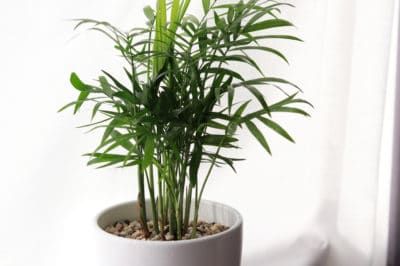What is an Areca Palm?
Native to Madagascar, the areca palm has naturalized to many tropical and subtropical regions of the world. Also known as golden cane palm, yellow palm or butterfly palm, it is a popular houseplant and is also frequently found in offices and outdoors. The plant grows relatively fast under the proper conditions and is easy to divide. It flowers in its normal range but not indoors.
What Varieties are Available?
The term areca palm is a catch-all for a number of related species. You may have to look hard to find different varieties, but these are possibilities:
- Dypsis lutescens – the most common and widely planted areca palm; readily available.
- Dypsis decaryi – the triangle palm; massive and once common in the wild but now threatened and rare.
- Areca catechu – the betel nut palm; occasionally available, used in malls and other large buildings.
What Soil Does Areca Palm Need?
Like many tropical plants, areca palms need soil with plenty of nutrients that drains very well. Standard potting soil is a good choice. Adding material that will promote drainage, such as peat, also helps give an areca palm the growing medium it prefers. In addition, you should fertilize with a weak water-soluble organic fertilizer twice during spring and summer. Hold fertilizer in fall and winter.
If grown outdoors, plant in an area that has soil that drains well and doesn’t have a tendency to retain water. It thrives in a variety of well-drained soil types.
How Fast Does Areca Palm Grow?
Growing conditions affect the palm’s growth rate. Under the right conditions, an areca palm may grow as much as two feet a year. Most indoor gardeners, however, are constrained by light levels, indoor temperatures and other factors that can slow growth. It’s best to assume that your palm will not grow very fast, which is one reason why people often buy a larger specimen to begin with. If grown outdoors in proper conditions, areca palms grow relatively fast.
How Do I Choose A Container?
An areca palm will grow in almost any kind of container. The plant prefers tight quarters, so don’t buy a big pot for a small plant. No matter what kind of container you choose, it should drain well. The pot should be about twice the size of the palm’s root ball. Even a large plant needs only about a foot of soil depth.
Where Should I Place It?
Areca palms need lots of light, but don’t do well in direct sunlight. Bright indirect light is the best choice. The palm will also do better with morning sunlight than afternoon sunlight. Allowing the palm to receive a few hours of early morning direct light is ideal. If you only have a south-facing window, use shades or curtains to screen the plant from intense sunlight later in the day. Planted outdoors, situated the palm in a locations that receives partial sun to partial shade.
What About Watering?
In spring and summer – the prime growing period – areca palms need more water. Water often enough to keep the soil slightly moist. Do not let the plant sit in water, however, as waterlogged roots are susceptible to disease. During the fall and winter, you can let the soil dry out slightly. If the plant begins to wilt, it needs water.
How Do I Prevent Salt Build-up?
Areca palms are sensitive to salts and should not receive water that has been chemically softened. If you use municipal tap water, let it stand overnight in an open wide mouth container to dissipate chlorine or fluoride. You may need to use distilled water if you have a water softener. Even if you use these preventive strategies, your palm will probably need to be leached once or twice a year.
How Do I Leach an Areca Palm?
Leaching is easy, but you must be able to get the palm into the bathtub or outside. Slowly pour warm water over the soil, making sure to wet the root ball thoroughly. Rainwater is ideal, but distilled water also works well. Use twice the pot volume – a gallon pot needs two gallons of water. Let water drain completely. Repeat every four to six months.
Any Diseases or Pests?
Spider mites and mealy bugs are the primary insect pests of areca palms. Both can usually be controlled with insecticidal soap. Use it at one half the recommended strength to prevent frond damage. Pink rot and ganoderma are the most common diseases. Both can be prevented by not over-watering, but neither can be cured.
